225th anniversary of the Treaties signed in Paris
on 6 February 1778.
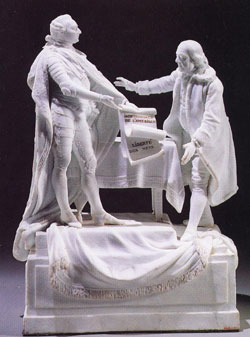
|
the American representative, Franklin, the 1778 Treaty.
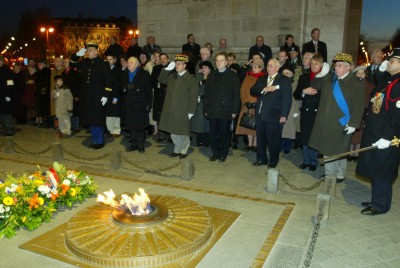
|
Flame ceremony at the Arc de Triomphe 6 February 2003 |
|
de gauche � droite : Le chef d'escadrons JEDRAZIAK, de l'�tat-major militaire du pr�sident du S�nat. Monsieur le s�nateur Jacques HABERT. Le g�n�ral de division de BOUTEILLER, repr�sentant le Ministre de la D�fense. Le repr�sentant des Ing�nieurs de France. Mr. B. Rice ASTON, President General Sons of the American Revolution. Monsieur H�lie de NOAILLES, duc d'AYEN, pr�sident de la Soci�t� en France des Fils de la R�volution Am�ricaine. Le g�n�ral de corps d'arm�e COMBETTE, pr�sident du Comit� de la Flamme. | |
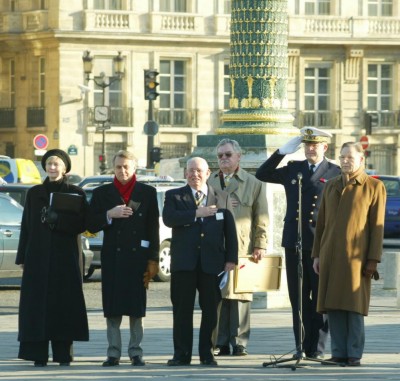
|
Parade and wreath laying at Place de la Concorde 6 February 2003 |
|
de gauche � droite : Mrs Ren�e EARLE, Ministre conseiller aux affaires culturelles, repr�sentant SE Howard H. Leach, ambassadeur en France des �tats-Unis d'Am�rique. Monsieur H�lie de NOAILLES, duc d'AYEN, pr�sident de la Soci�t� en France des Fils de la R�volution Am�ricaine. Mr. B. Rice ASTON, President General National Society Sons of the American Revolution. Le contre-amiral GUILLAUD, repr�sentant le Pr�sident de la R�publique. Le comte de TRENTINIAN, Executive vice-president de la Soci�t� en France des Fils de la R�volution Am�ricaine. | |
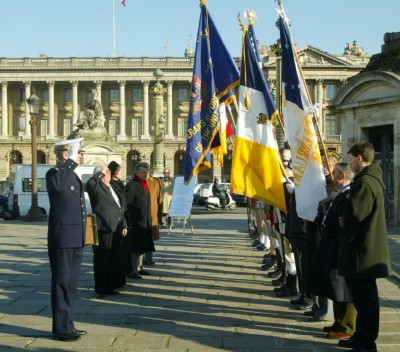
|
In front of l'H�tel de Marine. 6 February 2003 |
| Les autorit�s passent en revue les drapeaux des v�t�rans et des associations patriotiques | |
Of additional note for year around visits to Paris: There is a published guide to visiting Paris' sites that relate to the American Revolution, many of which are pertinent to the signing of the Alliance. This is a booklet suitable for carrying while walking the streets of Paris. It was prepared by Daniel and Alice Jouve, and Alvin Grossman and is titled: Paris: Birthplace of the USA; A Walking Guide For The American Patriot (Daniel Jouve, 9 Place Vauban, Paris, 1955).
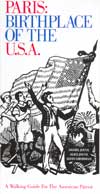
| This pocket guide-book of Paris focuses on 23 locations closely related to the birth of the U.S.A. as an independent country over 200 years ago. The booklet can be ordered at the website A Walking guide for the American Patriot. |
| For background on the Franco-American Alliance, see the webpage The Franco-American Alliance of 1778-1800 for a brief summary and for links to further in depth material. |
COMMEMORATION of the 1778 ALLIANCE at CARPENTERS' HALL, PHILADELPHIA.
Mr. John A. Nagy (of the Philadelphia American Revolution Round Table) on "French Spies in the American Revolution."
Dr. Robert Selig (a principal scholar on the French in the American Revolution) on "225 Years ... The French Alliance in American History." See: text of this presentation.
SYMPOSIUM on THE FRENCH ALLIANCE , YORKTOWN, VIRGINIA.
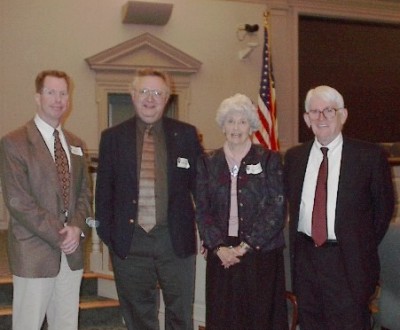
From left to right: Dr. Gregory D. Massey, Dr. Robert Selig, Mme. Claude-Anne Lopez, and Dr. Samuel F. Scott.
PROGRAM:
"History of the French Alliance," Robert Selig, PhD. See: text of this presentation.
"Winning the Hearts, Minds � and the Treasury, � of the French," Claude-Anne Lopez.
"John Laurens; His 1781 Mission to Paris," Greorgy D. Massey, PhD.
"The Aftermath of Victory: the French Army in Virginia after Yorktown," Samuel F. Scott, PhD.
A scheduled 'Walking Tour of French Occupied Yorktown', Mr. John Short, Park Ranger was cancelled due to weather.
THE AMERICAN REVOLUTION ROUND TABLE of the District of Columbia PROGRAM on the FRENCH and AMERICAN 1778 ALLIANCE , FORT MYER, VIRGINIA.
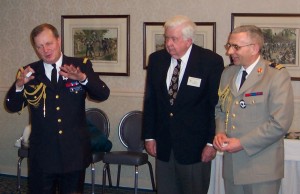
|
General Bastien (left) addresses the ARRT on the continuing spirit of the French-American Alliance, following
a presentation by Mr. Jack Bowler (center) of the paperweight mementos with the ARRT's logo to the general and to Colonel Tichit (right). |
The speaker, Albert D. McJoynt, described the Alliance's origins, motives of the participants, essential ingredients, and the nature of its duration. In so doing, the speaker countered some misconceptions and misunderstandings about the alliance that are often repeated in popular literature on the American Revolution.
COMMEMORATION of the 225TH ANNIVERSARY of the FRANCE-U.S. TREATY of AMITY and COMMERCE at the THE ROBINSON HOUSE in CLAYMONT, DELAWARE.

|
The opening began with a procession led with the flags used by the US and France in 1778. |
- An "official" welcoming ceremony beginning at 12:30 p.m., with 'General Lafayette' escorted in by an honor guard, militiamen, and a fife and drum corps.
- Gen. Lafayette's speach was followed by a fife and drum corps mini-concert.
- Dr. Robert Selig, a nationally recognized scholar on the Franco - American efforts of the American Revolution spoke on the Alliance.
- A chamber music concert of French and American music ended the the program.
Kim Burdick, a prominent historical consultant in the area, was the Program Chairperson. The program was organized by The Washington - Rochambeau Revolutionar Route (W3R) - Delaware Committee (Ray Hester, Chairperson), and supported with contributions by New Castle County Council, the Delaware Heritage Commission. The Claymont Historical Society & the Darley Society provided use of the Robinson House. Dr. Selig's talk can be viewed at text of this presentation.
Report of this event was provided by Ralph Nelson (Delaware Society, SAR), who sponsors the The Washington - Rochambeau Revolutionary Route Historic Trail Association
website.
A full photo-report on the event is available at http://amrevandfrance.com/w3r-de/feb08-de.htm
6 FEBRUARY 2003
COMMEMORATIVE CELEBRATION of the 1778 TREATY BETWEEN FRANCE and THE UNITED STATES HELD at the RESIDENCE OF THE CULTURAL SERVICES of the FRENCH EMBASSY, NEW YORK CITY.
Event was hosted by the New York City Chapter of the National Society of the Daughters of the American Revolution (NSDAR), French Consul General Richard Duqu�, and Monsieur Jean Ren� Gehan. Post opening ceremonies reception was conducted by the New York Chapter of the Sons of the American Revolution (SAR) and the American Society of Le Souvenir Fran�ais, The Hudson River Valley Institute, which helped to plan the event has posted a webpage that describes the program; see http://www.hudsonrivervalley.net/AllianceDay.php
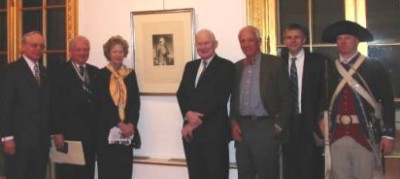
| Among the attendees were a number of early supporters of the Washington Rochambeau Revolutionary Route (W3R) historic trail initiative. Some shown here gathered around the comte de Rochambeau's portrait. |
6 FEBRUARY 2003
COMMEMORATION CONDUCTED at the OLD STATE HOUSE, HARTFORD, CONNECTICUT
[Report pending]
3-4 May 2003
COMMEMORATION CONDUCTED at VALLEY FORGE, PENNSYLVANIA
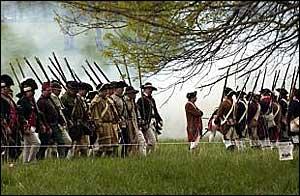 Valley Forge National Historical Park's 225th Anniversary of the French Alliance
was a series of programs that included visits to the encampment grounds, demonstrations of military marching and musket firing, panel discussions, and speeches. The overall program was a particular commemoration of the event directed by George Washington in May 1778.
Valley Forge National Historical Park's 225th Anniversary of the French Alliance
was a series of programs that included visits to the encampment grounds, demonstrations of military marching and musket firing, panel discussions, and speeches. The overall program was a particular commemoration of the event directed by George Washington in May 1778.
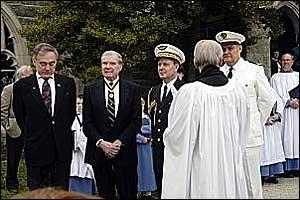 Group outside the Washington Memorial Chapel, from left to right :
Group outside the Washington Memorial Chapel, from left to right :
H. Lynn Breaux, Ambassador to France of the NSAR;
Col Stewart Boone McCarty, Jr. USMC (Ret), NSAR;
Major General Daniel Bastien, French Defense Attach� to the US;
(seen from the back) Reverend R. James Larsen, Rector of the Washington Memorial Chapel;
Jean-Loup Archawski, commander, French naval reserve.
- Three important themes describe this commemoration, each is covered in a separate page:
- A description of what happened in May 1778 at Valley Forge.
- General Washington's Proclamation in 1778.
- Speech given by the French Defense Attach� to the United States in 2003.
Return to top of this page
Return to main webpage on The Franco-American Alliance of 1778-1800.
Return to webpage on Perspective on the French-American Alliance
This page is sponsored by The Exp�dition Particuli�re Commemorative Cantonment Society .
Page created 11 November 2002; revised 12 February 2004.